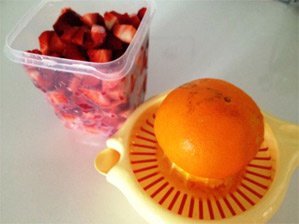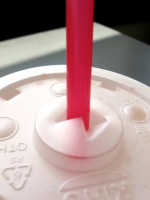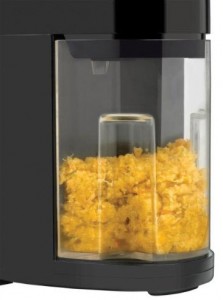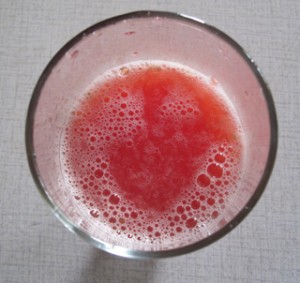Paleo Diet and Juicing

Are you new to Paleo diet and want to know if fruit juices are the way to go? Do you have dilemmas regarding home made juices versus commercial brands? How about 100% pure fruit juices, are they allowed? Read on for a detailed explanation.
From a Paleo diet perspective, you don’t really need to include a whole lot of juices, and especially not fruit juices. The main reason is that they are loaded with sugars (glucose) and what’s even worse fructose (really, really bad type of sugar).
As you might or might not know, by definition Paleo diet is low in carbohydrates. All carbohydrates of digestible type (complex sugars) turn into simple sugars in our body during digestion, creating imbalances, spikes and crashes of our blood sugar as well as strong insulin response. This harmful cascade is, in fact, what Paleo tries to minimize.
 Commercial juices are even worse. They are loaded with artificial coloring, artificial sweeteners (like the notorious aspartame) preservatives, extra added sugar, and synthetic flavorings.
Commercial juices are even worse. They are loaded with artificial coloring, artificial sweeteners (like the notorious aspartame) preservatives, extra added sugar, and synthetic flavorings.
In addition to the above general remarks, juices are known to be prone to oxidative damage. It means you will lose many of the nutritive substances if you don’t drink the juice immediately. The more you wait the more you lose. That’s why packaged juices are especially questionable.
Table of Contents
Sugar Cravings
Some people are obsessed with sweet beverages. For them, the freshly squeezed fruit juices could be a somewhat better alternative than the sugar loaded soda drinks.
By the way, home made juices are a much better choice when compared to the packaged juices in every respect, especially if you prepare them from organic fruits. You will avoid the added sugar, and possibly any of the harmful chemicals, pesticides, and insecticides. Because of the pasteurization, some of the commercial juices also lack the enzymes, vitamins, and nutrients present in the home made juices. Others are better in that respect.
When are Juices Acceptable in Paleo Diet?
- If you are on a Paleo diet, the only time you would want to drink juice is probably if you try to gain weight.
- Or if you have gut flora overgrowth, or some other condition that prevents the normal and beneficial digestion of the fiber found in fruits and vegetables. In such cases, having less fiber is not a drawback.
- Or, if you are a beginner in the Paleo world, and if your digestive system is compromised due to consuming crappy foods, juices can actually be beneficial for a short period of time. This is because they are much easier to digest, and don’t put any burden on the body.
So, the bottom line is, if you can’t eat vegetables and fruits for some reason, juicing might be a way to go. If you can, however, there is no reason why you should replace the whole foods with juicing.
What’s Wrong with Juicing from the Paleo Standpoint?
First of all, fruit juices are high in glucose. The glycemic index of many fruits you would want to squeeze into juice (with a few exceptions) is very high. They create sharp spikes in blood sugar. That’s why fruit juices are not recommended if you want to lose weight or if you have type 2 diabetes. But even if you are completely healthy and fit, fruit juices might still get you on a blood glucose roller coaster.
Another problem is the lack of fiber in the juice. The fiber, when the whole fruit and vegetable is ingested, acts as a buffer that keeps the blood sugar levels lower.
 The fiber is the part of the fruits and vegetables we cannot digest, but our gut flora can.
The fiber is the part of the fruits and vegetables we cannot digest, but our gut flora can.
The fiber also keeps you satiated, and at the same time there is not a whole lot of calories in the fiber anyway. Moreover, it keeps your gut flora happy, which is essential for optimal health.
Yet another problem is fructose. Fruits are rich in fructose, and fructose is one of the most detrimental types of sugar. Fructose is what your liver doesn’t really need, and at the same time, fruit juices are lacking some essential micro-nutrients, like selenium, which your liver does need.
In any case, stay away from the following juices:
- Grape juice
- Orange juice
- Chinola juice
- Starfruit juice
- Apple juice
- Mango juice
- Strawberry juice

But I Really Have to Drink Juices
If you absolutely have to prepare juices, water them down. Use something like 4 parts of water for one part of juice. Or even better juice fruits together with vegetables, like spinach, celery, and kale. The veggies will reduce the glycemic response and will keep your insulin levels lower than without vegetables. Except for carrots and beets, which also have a high effect on the blood sugar and insulin response.
Eat the Whole Fruits Instead
Instead of juicing, eating whole fruits could be in line with Paleo diet, as long as you do that in moderation.
If you’ve already included fresh vegetables and fruits as a part of a healthy Paleo diet, you don’t have to add a lot of juiced ones. Check also this post for a list of drinks you should typically steer clear of while on Paleo diet.

Min actually helps curb a sweet tooth. I drink it as mint tea. I use raw honey (not sure if that is okay or not) for sweetness. It has an interesting taste and really helps cleanse me. I can feel the difference after drinking it. I always say juice is great but only when it is 33/33/33. Being 33% water, 33% vegetable, and 33% vegetable. I still do enjoy some straight fruit juice when I need the energy.
Hi,
Mint is great, I love it too. I’m not sure about honey and Paleo, but to my mind honey is good only in small doses. After all and despite all its benefits, it’s about 35% fructose and 35% glucose. Too much sugar if you ask me.